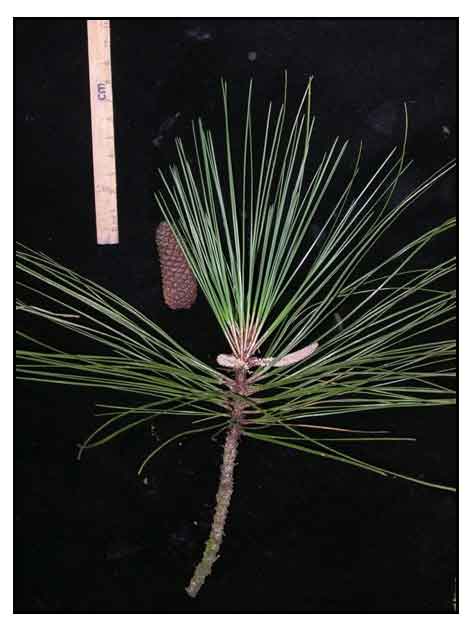|
 Botany Botany
A fast-growing evergreen, coniferous tree growing
to a height of 30 to 45 meters. Bole is straight with a diameter of 50 to 80 centimeters. Lower branches are large, horizontal and drooping, the upper branches are ascending to form a rounded pyramidal crown. Leaves are in fascicles of 3 to 5, glossy dark
green, up to 30 centimeters long. Cones are conic-oblong, up to 15 centimeters long.
Distribution
Recently introduced to the Philippines.
Found in the high altitude areas of the Mountain Province.
Occasionally cultivated in the lowlands where it thrives poorly.
Constituents
• Crude leaf extracts showed resin characteristics with pH around 3.), attributable to phenolic acid.
• Bark yields procyanidins.
• GC-MS and CC analysis of fresh needles for essential oil yielded 44 constituents by hydrodistillation, largely dominated by monoterpene hydrocarbons (83.6%). Among the sesquiterpenes, there was an abundance of limonene (42.9%) and beta-phellandrene (24.4%), beta-caryphyllene (7.6%). (10)
• GC-MS and CC analysis of needles of P. caribaea yielded 39 compounds. The most abundant components were limonene (38.6%), α-pinene (27.6%), borneol (6.7%), and myrcene (3.5%). Aristolene, ledol, and guaiol were reported for the first time. (11)
Parts used
Leaves, bark, latex.
Uses
Edibility
- Seeds are edible, raw or cooked.
Folkloric
- No recorded folkloric
medicinal use in the Philippines.
- Oil of turpentine: Obtained from the oleo-resin of all pine trees is antiseptic, antispasmodic, astringent, and vermifuge. Applied externally as liniment plasters and poultices or used as herbal steam baths and inhalers. (9)
- Leaf oil used for medicinal baths.
Others
- Reforestation: In Sri Lanka, a reforestation was done with the tree in heavily eroded lands. It is the only species of tree successfully used to reforest barren, eroded, and denuded lands with tree cover. :(9)
- Oleoresin: Sapwood yields oleoresin, a pale yellow, clear and sticky mass, which on distillation yields gum rosin (75%) and turpentine (25%). Gum rosin is used in making paper, soap and glue; turpenstine is used in the pain and batik industries. :(9)
- Tannin: Bark yields tannin. :(9)
- Wood: Light to moderately heavy, moderately durable, susceptible to borer and termite attacks, but resistant to beetles and fungi. yields tannin. Limited construction use; suitable for turnery, toys, moulding, trim work, veneer, plywood, particle board, fiber board, etc. :(9)
- Adhesive: Bark yields wood adhesive.
 Studies Studies
• Antioxidant
/ Antimutagenic: A study showed Pinus caribaea and C.
citratus extracts were antigenotoxic suggesting antimutagenic components
and activity unlike its antioxidant activity.
• Antimicrobial: One of the plants
extracts in a study to evaluate antimicrobial activity, Pinus caribaea
showed moderate activity against Bacillus sp. (2)
• Larvicidal / Aedes aegypti / Lignins: Study evaluated the larvicidal activity of dried leaf extracts of Pinus caribaea against Aedes aegypti. Results showed the acetone extract to be the most active, and the larvicldal activity was associated with lignin concentration. (3)
• Pulping Studies: Study evaluated Pinus caribaea var. hondurensis and Pinus oocarpa for their potential as pulpwood species. Caribaea yielded 45% and P. oocarpa yielded 46% of pulp with a kappa no of 40. All mechanical and thermo-mechanical pulps from these species were suitable for newsprint. (4)
• Procyanidins / Anti-Cancer / Radical Scavenging Activity: Study evaluated the biological activities of procyanidins from the bark of Pinus caribaea. Study showed strong radical scavenging activity using a DPPH assay. Study also showed a strong inhibitory effect of the bark procyanidins on promyelocytic cells HL-6), an effective inhibition on human adenocarcinoma cells BGC-823, and human hepatocellular carcinoma cells BEL-7402. (5)
• Bark Tannins / Antigenotoxic Against Gamma-Rays: Study evaluated the genotoxicity and antigenotoxicity of a tannin fraction from the bark of Pinus caribaea against gamma-rays. Results showed antigenotoxic activity against gamma-rays when in experimental E. coli cells were pre- or co-treated with the extracts, but no during post-irradiation treatment. (6)
• Healing Effect on Aseptic Open Wound / Paste from Green Foliage: Study evaluated the wound healing activity of chlorophyll carotene pases from green foliage of P. caribaea var. caribaea in wound wounds in rats. Results showed significant reduction in wound areas at 8 and 11 days, along with histological evidence of high percentage of wound healing in Phase II of the epidermis and dermis. Results were comparable to drugs from Rhizophora mangle. (6)
• Activated Carbons / Sawdust: Study has reported on the production of activated carbons from P. caribaea sawdust through use of CO2 and steam activating agents. (13)
Availability
Wildcrafted.
|

![]()

